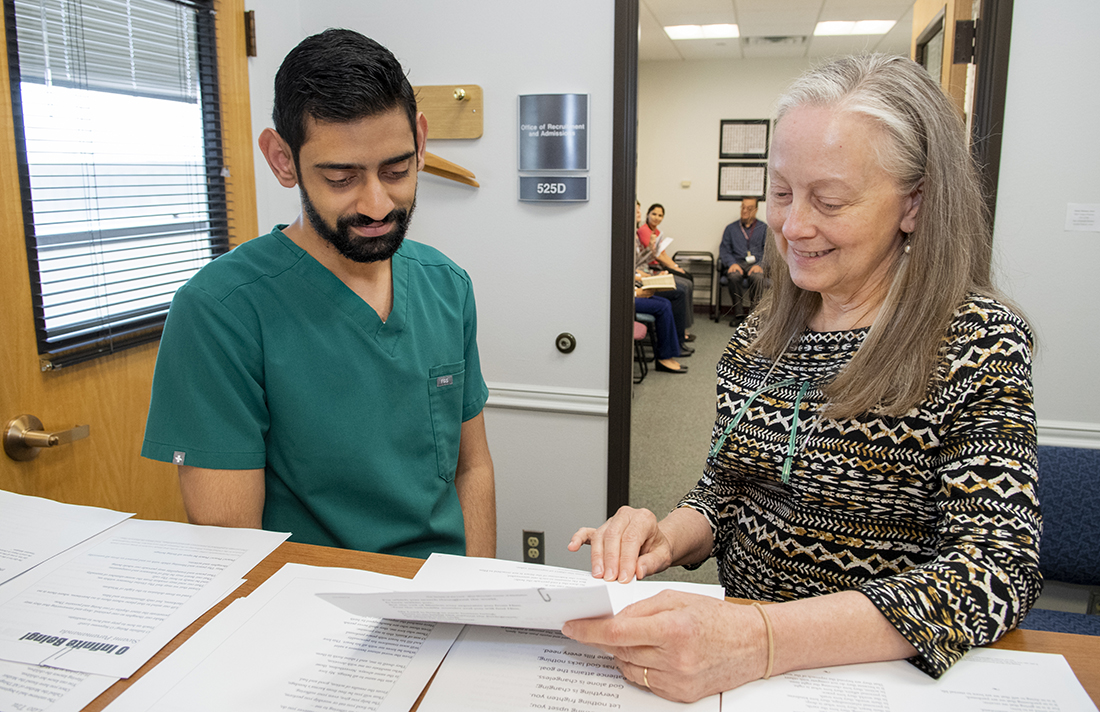Finding time for inner zen

Reduced anxiety before exams, increased calm during emergencies, more patience for patients (and for students, faculty or family members), and a serving heart are ways that meditation can complement the dental profession and health care overall, says Dr. Barbara Miller, executive director of recruitment and admissions.
For years, she has led students in 30-minute sessions at Texas A&M College of Dentistry. This semester’s midday sessions in Room 525—now also open to staff and faculty—are a part of the college’s Health and Wellness Task Force’s offerings to reduce stress.
Miller started offering meditation sessions after a handful of students requested to learn more about it. She has long suggested meditation as a coping tool for anxious students seeking guidance.
“I put together a handout of techniques for students who are stressed and have test anxiety, especially for a big test, like the board exam,” she says. “The students who tried it said that it really helped them.”
Miller follows a meditation practice based on the teachings of Eknath Easwaran, the founder of passage meditation and the Blue Mountain Center of Meditation. He wrote 40 spiritual books and started the first meditation course for credit on a university campus at the University of California-Berkeley.
Easwaran’s eight-point program emphasizes meditating on a passage, repeating a mantram, slowing down, focusing on one thing at a time, training the senses, putting others before self, spiritual fellowship and spiritual reading.
In meditation, the foundation of the practice, the meditator selects an inspirational reading (or passage) that often reflects their own spiritual upbringing or maybe one from a different tradition.  With a nod to the college’s diverse student body and employees, Miller comes to meditation sessions with a wide-ranging selection of passages to offer, including Baha’i, Buddhist, Christian, Hindu, Jewish, Muslim and Taoism, among others. “We’re encouraged to select and memorize a variety of passages that are positive, practical and uplifting,” she says.
With a nod to the college’s diverse student body and employees, Miller comes to meditation sessions with a wide-ranging selection of passages to offer, including Baha’i, Buddhist, Christian, Hindu, Jewish, Muslim and Taoism, among others. “We’re encouraged to select and memorize a variety of passages that are positive, practical and uplifting,” she says.
“In our very hectic, sped-up society, we need something to hold onto when we’re trying to meditate. The words of the passage become our lifeline,” she says. Multitasking and smartphones have only made the problem worse.
The practice also encourages the repetition of a mantram throughout the day so it becomes routine and at the ready if needed during stressful situations.
“Many different world traditions have a mantram or prayer word that has been used over the centuries in times of grief or anxiety,” Miller says. “The mantram can be used at any time—day or night. With the mantram, you choose one and stick with it. Even for those who can’t seem to find the discipline to practice mediation, the mantram can be very helpful.”
For those who aren’t interested in organized religion, meditation is still applicable, she says. Instead of praying to a god or higher being, the focus becomes aspiring to a higher ideal of humanity or connecting with the universal consciousness.
Thirty minutes of passage meditating, first thing in the morning, is ideal; this length of time gives the mind a chance to truly pull away from our fast-paced world and the demands that go with it.
By following the Eight Points of Passage Meditation, students and dental school employees will become more patient, selfless and calm, to name a few, she says. “These are helpful traits for a dentist, as well as any other kind of health care professional.”
Miller starts each session with a “thought for the day” from an author, philosopher or other well-known figure. In the darkened room, participants then meditate on their passage while sitting straight in a chair, feet on the floor, eyes closed. Slowly, silently in the mind, recalling each word while moving through the passage—but not too slowly—helps them stay on track.
“If your mind drifts away, gently bring it back to the first word of the passage,” she says. With sustained effort, the meditator will become more skilled in dealing with the many distractions, focusing their attention and thoughts where they want.
“The beauty of this is that once you’ve memorized a passage, you can do it anywhere without any electronic device,” Miller says.
Teaching the mind to slow down thoughts also translates well to patient care, giving someone “a little space of time to make a conscious decision on how you’re going to respond,” she says, allowing a person to be “more kind and compassionate. In health care and education, that’s so very important.”
Miller recommends that anyone wanting to fit meditation into their hectic life could try waking up 30 minutes earlier to open up a slot to break away for meditation.
“There’s always something else to do,” says regular attendee Richard Cardenas, program manager in the research and graduate studies office. “I put it on my calendar and I make myself go.”